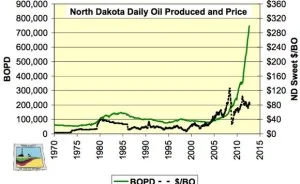Kodiak Oil & Gas ended 2012 with 94.8 mmboe of proved reserves (85% oil) in the Williston Basin. That's up 138% from 39.8 mmboe at year-end 2011. Just under half of the company's reserves (46%) are proved, developed, and producing (PDP). Production is expected to grow to 29,000-31,000 boe/d in 2013. That's almost double the ~15,000 boe/d the company produced in 2012 (18,200 boe/d in Q4).
Kodiak spent $810 million developing the Bakken in 2012. Guidance for the year was $738 million, but the company spent more as drilling efficiencies allowed more wells to be drilled and good weather allowed for more activity in the fourth quarter. Kodiak has planned to spend $775 million in 2013 - $740 million for drilling and completing wells, along with $35 million for waste water disposal, well connections, and acreage acquisitions.
The company plans to continue operating seven rigs going forward. Four rigs are operating in Williams County, two in McKenzie County, and one in Dunn County. The company also employs two dedicated frack crews.
Two tests are also underway where the company will drill 12 wells in one 1,280-acre spacing unit. One unit is located in the Polar area and one in the Smokey area (see map above).
The company will also expand drilling in the Three Forks:
Kodiak's Chairman and CEO Lynn Peterson said: "Regarding the TFS, we believe the multiple intervals of TFS appear to exist only through the deeper part of the Williston Basin where the TFS is thicker and more thermally mature. We continue to view the TFS as a single hydrocarbon system. Based upon our fracture stimulation analysis, we believe that the production does communicate between the TFS intervals; however, due to the expanding thickness of the oil saturated reservoir, additional well bores are required to optimize reservoir drainage. We do not believe the lower TFS interval exists throughout our entire acreage block, but that the interval is most likely present in the southern portion of our Polar acreage block and in our Koala and Smokey blocks. The tighter density of well bores in the Middle Bakken will likely be effective only through these same geographic areas as well as in our Dunn County acreage where we continue to achieve strong well results."





